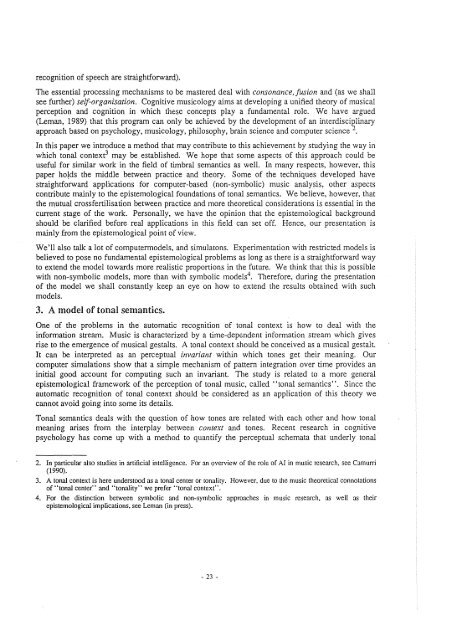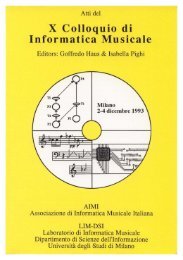Proceedings IX CIM 1991, Genova, November 13-16 - AIMI
Proceedings IX CIM 1991, Genova, November 13-16 - AIMI
Proceedings IX CIM 1991, Genova, November 13-16 - AIMI
Create successful ePaper yourself
Turn your PDF publications into a flip-book with our unique Google optimized e-Paper software.
ecognition of speech are straightforward).<br />
The essential processing mechanisms to be mastered deal with consonance, fusion and (as we shall<br />
see further) self-organisation. Cognitive musicology aims at developing a unified theory of musical<br />
perception and cognition in which these concepts play a fundamental role. We have argued<br />
(Leman, 1989) that this program can only be achieved by the development of an interdisciplinary<br />
approach based on psychology, musicology, philosophy, brain science and computer science 2.<br />
In this paper we introduce a method that may contribute to this achievement by studying the way in<br />
which tonal contexf may be established. We hope that some aspects of this approach could be<br />
useful for similar work in the field of timbral semantics as well. In many respects, however, this<br />
paper holds the middle between practice and theory. Some of the techniques developed have<br />
straightforward applications for computer-based (non-symbolic) music analysis, other aspects<br />
contribute mainly to the epistemological foundations of tonal semantics. We believe, however, that<br />
the mutual crossfertilisation between practice and more theoretical considerations is essential in the<br />
current stage of the work. Personally, we have the opinion that the epistemological background<br />
should be clarified before real applications in this field can set off. Hence, our presentation is<br />
mainly from the epistemological point of view.<br />
We'll also talk a lot of computermodels, and simulatons. Experimentation with restricted models is<br />
believed to pose no fundamental epistemological problems as long as there is a straightforward way<br />
to extend the model towards more realistic proportions in the future. We think that this is possible<br />
with non-symbolic models, more than with symbolic models 4 . Therefore, during the presentation<br />
of the model we shall constantly keep an eye on how to extend the results obtained with such<br />
models.<br />
3. A model of tonal semantics.<br />
One of the problems in the automatic recogmtlOn of tonal context is how to deal with the<br />
information stream. Music is characterized by a time-dependent information stream which gives<br />
rise to the emergence of musical gestalts. A tonal context should be conceived as a musical gestalt.<br />
It can be interpreted as an perceptual invariant within which tones get their meaning. Our<br />
computer simulations show that a simple mechanism of pattern integration over time provides an<br />
initial good account for computing such an invariant. The study is related to a more general<br />
epistemological framework of the perception of tonal music, called "tonal semantics". Since the<br />
automatic recognition of tonal context should be considered as an application of this theory we<br />
cannot avoid going into some its details.<br />
Tonal semantics deals with the question of how tones are related with each other and how tonal<br />
meaning arises from the interplay between context and tones. Recent research in cognitive<br />
psychology has come up with a method to quantify the perceptual schemata that underly tonal<br />
2. In particular also studies in artificial intelligence. For an overview of the role of AI in music research, see Camurri<br />
(1990).<br />
3. A tonal context is here understood as a tonal center or tonality. However, due to the music theoretical connotations<br />
of "tonal center" and "tonality" we prefer "tonal context".<br />
4. For the distinction between symbolic and non-symbolic approaches in music research. as well as their<br />
epistemological implications, see Leman (in press).<br />
- 23 -



